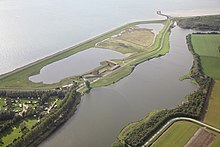 | ||
| Ouwerkerk | ||
| province | Zeeland | |
|---|---|---|
| Residents | 650 (2010) | |
| height | unknown | |
| no value for height on Wikidata: | ||
| no tourist info on Wikidata: | ||
| location | ||
| ||
Ouwerkerk (Ausptache: Auwerkerk) is a village in the east of Schouwen-Duiveland in the Dutch province Zeeland.
background
The Ouwerkerk, which was probably founded in the 12th century, was the oldest village on the former island of Duiveland. Its appearance is mainly due to the reconstruction of the fifties and sixties of the 20th century. embossed. In 1944 retreating German soldiers blew up the tower of the medieval village church. The damage was so severe that the whole church had to be demolished. Eight years later the village was inundated by the floods of the Oosterschelde after the dyke burst in three places. For months, the villages of Ouwerkerk and Nieuwerkerk lay like small islands in the water of the Oosterschelde. Every sixth ouwerk dungeon drowned.
getting there
By plane
By train
- from East and North Germany:
- IC to Amsterdam C; change there in IC to Vlissingen. Get off in Goes. The travel time between Amsterdam and Goes is 2 hours.
- from southern and western Germany:
- ICE to Amsterdam C; change there in IC to Vlissingen. Get off in Goes. The travel time between Amsterdam and Goes is 2 hours.
- IC from Venlo to Breda; Change to train to Roosendaal; there change to Stop clean to Vlissingen. Get off in Goes.
- from Maastricht to 's-Hertogenbosch; there change to IC to Roosendaal; there change to Stop clean to Vlissingen. Get off in Goes.
- in Goes switch to the bus to Zierikzee.
By bus
In the street
- From north and east Germany:
- A7 / N7 Groningen, A28 Assen - Hoogeveen - Zwolle - Amersfoort - Utrecht; A27 Gorinchem - Breda; A59 Roosendaal - Vlissingen
- From West and South Germany:
- BAB3 to GÜG Elten; A12 Arnhem - Utrecht; A27 Gorinchem - Breda; A59 Roosendaal - Vlissingen
- or
- GÜG Venlo A67 Eindhoven; A2; A58 Breda - Roosendaal - Vlissingen
- from the A58 in Goes to the A256. This later changes into the N256 and leads to Zierikzee. Take the N59 towards Ritterdam. The next exit leads to Ouwerkerk.
- (Of course it would also be possible to travel to Schouwen-Duiveland via Rotterdam. These routes are mostly overcrowded.)
By boat
mobility
- The buurtbus 190 connects Ouwerkerk with Zierikzee.
Tourist Attractions

- 1 Watersnoodsmuseum (Watersnoodmuseum), Weg van de Buitenlandse Pers 5. Tel.: 31(0)111-644382.. Open: Nov 1, 2014 - Apr 1, 2015: Tue - Sun 10 a.m. - 5 p.m. Apr 1 - Nov 1, 2015 daily 10 a.m. - 5 p.m.Price: 9 €.Accepted payment methods: Museum card.
- On November 6, 1953, the last of three holes in the Oosterscheldedeich was closed with four Phoenix caissons. These caissons were actually intended for a second Allied landing in Ostend. In 1953 they were brought from England to the Netherlands. The consequences of the flood disaster can be seen and felt throughout the village. 1,835 people drowned, every sixth inhabitant. The Watersnnood Museum was opened in 2001 in one of the four preserved caissons. News pictures from that time show the disaster, the rescue and the help. The breakpoints of the dike are shown in a diorama. But the museum doesn't just show the need. After the disaster, all efforts were made to close the dikes. The technique used is still preserved and can be seen. In 2009 the museum was completely renovated and once again meets the requirements of today's visitors.
- Monument Ouwerkerk, Phoenixstraat. Two hands clasped together symbolize the adoption assistance after the disaster of 1953. Enschede was the sponsor community of Ouwerkerk, according to the inscription on the stone. The memorial was made by the artist Mari Andriessen, known from the "Dokwerker" in Amsterdam.
- Krekengebied Ouwerkerk. The nature reserve south of Ouwerkerk is a remnant of the floods of 1953. When all the land was reclaimed from the sea, it remained Kreken (Watercourses) over. The SBB State Forestry Office turned it into a local recreation area. In addition to fast-growing poplars, slow-growing trees such as oak, beech, elm and ash were also planted. There are sunbathing areas on the banks. The 8 km long leads through the area Krekenroute.
activities

- Farm De Stelle, Stelweg 3. Tel.: 31 (0)111 450198. Participate with the farmer. At farm De Stelle you not only see how things go on a farm, you can also help yourself. Pigs, rabbits and sheep want to be fed. In the orchard, visitors pick strawberries, blackberries, raspberries and currants. In business everything is weighed and paid for. In the kitchen, you can also use half a kilo of berries to make two pots of jam for at home. There is also a corn maze the size of a soccer field outside. From the beginning of June the corn is so high that children can get lost in it, and two weeks later adults too.Open: May Nov Sat, Jun - Sep Mon - SatPrice: variable.
- Krekenfeest, ring. It started as a festival for insiders and has grown into an event for outside visitors. Activities include abseiling down from the church tower, demonstration of shoeing horses, and a trip on the horse-drawn tram. Not unique, but nice.Open: 1st Sat in September.


